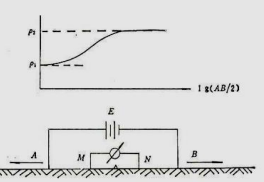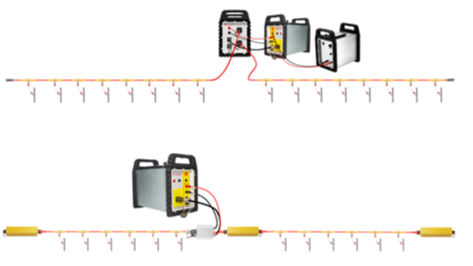
2022-06-14 09:54:01source:
Electrical exploration is based on electrical differences as the physical premise.
Apparent resistivity:Resistivity is used to represent the electrical properties of the distribution of various substances in the geological body, and its calculation formula is  、the K value is determined by different devices, which can be divided into sounding and profile.
、the K value is determined by different devices, which can be divided into sounding and profile.

1) The resistivity vertical sounding method is an important geophysical method to study the vertical geological structure. We can use its characteristics to determine the groundwater level and the depth from the surface. This type of curve is usually drawn on a double logarithmic scale, with the ordinate representing the value (in ohm-meters) and the abscissa (in meters). It can also be drawn as an apparent resistivity profile or a plane contour map
2) The electrical profile method studies the electrical changes of rocks along the horizontal direction of the survey line above the underground exploration depth. Different array can solve different geological problems. Compared with the electrical sounding method, the electrical profiling method is used to distinguish the different geological structure and structure changes in the underground horizontal direction, and the electrical profiling method can be used to delineate the horizontal distribution range of the target body. Observation results are drawn into profile section, pseudo section, plane contour map, etc.
2. Spontaneous potential:
In nature, the underground rock has an electric field due to the existence of water, including: filtering electric field, diffusion electric field and redox electric field.
3. Polarizability:
It is the main parameter measured by the IP method. It is an electrical exploration method based on the difference between the physical and electrochemical effects (induced polarization effects) of underground rocks and ores under the action of artificial electric fields. The biggest advantage is that it is less affected by terrain.

Polarizability: The strength of polarization is represented by the polarizability hs

In the formula, DV(T) is the total electric field potential difference measured before the power outage after a period of power supply T; it is the secondary field potential difference measured at the time T after the power outage.
4. Deviation (r):
There will always be some deviation between the measured discharge curve and the ideal straight line. The so-called deviation refers to the fitting error between the measured discharge curve and the straight line equation. We use the mean square error r to represent, Call it deviation.
In the formula, n is the number of sampling points; ![]() ; is the average value of the polarizability of each sampling point in the observation period; K is the slope of the decay curve, which reflects the total slope of the discharge curve in the observation period; B is a parameter reflecting the secondary field strength . Because it utilizes all the data of the discharge curve, its anti-interference ability is strong. When making the measured curve, the Y axis is r, and the X axis is AB/2
; is the average value of the polarizability of each sampling point in the observation period; K is the slope of the decay curve, which reflects the total slope of the discharge curve in the observation period; B is a parameter reflecting the secondary field strength . Because it utilizes all the data of the discharge curve, its anti-interference ability is strong. When making the measured curve, the Y axis is r, and the X axis is AB/2
5. Half-life time (Th):
The so-called half-life time refers to the time required for the secondary discharge field to decay from the maximum value after power-off to half, usually expressed by S. In actual work, in order to obtain a more obvious S value, the power supply time should not be too short, generally T is greater than or equal to 30 s. The measured curve takes the half-life Th on the Y-axis and AB/2 on the X-axis.
6. Attenuation: The formula for attenuation is:

That is, in the time period from 0.25 s to 5.25 s after the power failure, the ratio of the average value of DV2 to the DV2 value of 0.25 s is used as a parameter to measure the speed of the secondary field discharge. The smaller the D value, the faster the discharge, and the larger the D value,the slower the discharge. The abnormal peak value of the sounding curve of the attenuation parameter often corresponds to some geological interfaces and has a high correlation, which should be paid attention to in practical work.
7. Comprehensive IP parameters: its expression is:
![]() 。. Practice shows that the apparent half-time ( t S ) curve reflects the top of the aquifer clearly, but not the bottom boundary; the polarizability curve reflects the entire aquifer, but the anomaly is large in width and small in amplitude , the boundaries are blurred. In order to improve the resolution of these parameters, these two parameters can be integrated. The higher the Zs value, the better the water content. Due to the influence of the carbonaceous layer, the polarizability value is higher, but the decay is faster at half-life, which makes the comprehensive parameter Zs value smaller, so that the interference of the carbonaceous layer can be excluded,making the explanation more reliable.
。. Practice shows that the apparent half-time ( t S ) curve reflects the top of the aquifer clearly, but not the bottom boundary; the polarizability curve reflects the entire aquifer, but the anomaly is large in width and small in amplitude , the boundaries are blurred. In order to improve the resolution of these parameters, these two parameters can be integrated. The higher the Zs value, the better the water content. Due to the influence of the carbonaceous layer, the polarizability value is higher, but the decay is faster at half-life, which makes the comprehensive parameter Zs value smaller, so that the interference of the carbonaceous layer can be excluded,making the explanation more reliable.
8.Secondary time difference method:
It is not affected by pure terrain undulation and non-uniformity of surrounding rock resistivity, (measurement method is quadrupole sounding) to measure the first high-voltage and large current, and measure TH1 when half-life, and the second low-voltage small current , when the half-life time is measured TH2, then the secondary time difference is T=TH1-TH2, when the measured curve is made, the Y axis is the secondary time difference T, and the X axis is AB/2.
9.Metal factor:
JR=s /( s *100) Metal factor JS anomaly characteristics and the trend of major ore-controlling faults on the surface change characteristics, mineralization alteration characteristics, geophysical characteristics of the distribution of metallogenic elements, etc. It is concluded that: Apparent polarizability and apparent resistivity are related to the mineralization of polymetallic mineralization in the structural belt; the expansion part of the abnormal belt and structural belt is closely related to the mineralization alteration belt; the metal factor JS is effective in suppressing the high resistance and low polarizability of the body. The role of ore strata and the weakening of topography are of great significance.
In geological surveys such as mineral resources, engineering and environment, due to the variability and complexity of the geological background, it is difficult to use conventional electrical exploration to meet the needs of actual geological surveys. Th

To make a difference of this year's Dragon Boat Festival, Geomativeheld a celebration with the theme of "Love, shareand enjoy".The impression of the Dragon Boat Festival is different from that of "ZongziHow much do you knowAbout Dragon
